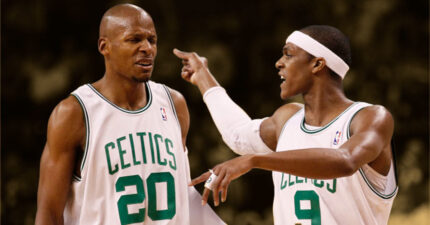Remember when X-Clan told us, “To the East my brother. To the East.”
Or when Brooklyn’s Blahzay-Blahzay was repping with; “When The East is in the house, ‘Oh my God.’ Danger!”
Remember when East Coast basketball conferences were incomparable and intimidating to the core? When cats rocked those Georgetown starter jackets in the winter and Syracuse Orangeman boxer shorts and matching hats in the summer.
That was “back in the days when I was young I’m not a kid anymore, but some days I sit and wish I was a kid again.”
When I was a yute’, East Coast was swinging; setting standards in music, athletics and culture. As NCAA basketball changed and talent started being dispersed throughout the country, Southern squads started coming up. It was similar to rap music and how the South has risen to the top of the hip-pop food chain and East Coast artists aren’t as prominent and feared as they once were.
Most experts are calling the NCAA’s East Region teams “pink cookies in a plastic bag, getting crushed by a building.” That building being The Southern region with No. 1 seed Florida and a gang of body collectors like UCLA, Pittsburgh, Ohio State, tournament plague VCU and an unpredictable Kansas squad. The other regions are flexing some heavy muscle too.
Don’t sleep on the East though.
Michigan State is a No. 4 seed but Tom Izzo’s NCAA cache is a major reason the Spartans are Vegas’ second choice at 9-2 odds to win it all. He’s led MSU to two National C’hips and seven Elite Eights. The team that is the hottest entering the tournament usually gets the support and MSU has been balling and shot-calling as of late. Branden Dawson is definitely an X-Factor because he gets every 50-50 ball. The health of Keith Appling is vital. Appling is known to lick off during the postseason. He still holds the record for most points scored in a Michigan High School Athletic Association Class A Basketball Championship. As a junior Appling scored 49 points to lead Detroit Pershing to a chip in 2009. He’s the type of talent that can change a game.
No. 1 seed Virginia won the ACC, but are consensus picks as the weakest link amongst the top dawgs. There are some potentially potent squads in the East region, but every team is flawed. As the tourney gets underway though, expect people’s unimpressed perception of the East region to change.
There are always surprise college squads – mid majors – that sneak into the Top-10 with help of an easy schedule, the luxury of a veteran team and prognosticators who legitimize them as real deals. But by the time the tournament hits and computer brackets must be clicked, March Madness minds tend to feel more comfortable riding with a traditional powerhouse than a “new” name. Izzo recently alluded to that weird Big Dance dynamic on Monday. “There were people that pronounced us dead a few weeks ago,” Izzo said at a NCAA press conference. “Now we’ve gone from the ugly duckling to the prom queen.”
More times than not, that’s the wise route to go. And in Michigan State’s case, No. 13-seed Delaware shouldn’t be too much of a problem. However, if that Cinderella team isn’t just a lucky bunch of chuckers, then immediate bracket destruction could follow. Butler obliterated brackets two seasons in a row during the Brad Stevens era. Wichita State and Harvard did it last season. Harvard’s upset of New Mexico last season has opponents keeping a close eye on them. The Ivy League kings won’t be able to sneak up on anyone this season. They are getting the press and the stress that teams like Gonzaga and Butler started getting as they cemented their programs as March Madness Marauders.
The East region's brand-named teams haven’t really impressed anyone on the court this season, but their histories alone give fans hope in an NCAA Tournament, single-game elimination setting.
UConn has been equally brilliant and bad at times, but they showed similar inconsistencies in 2011 when they rode the guard play of Kemba Walker and his 23.5 ppg to an unexpected NCAA title.
They have a two-headed monster at guard this season with Shabazz Napier and Ryan Boatwright. The Mobb Deep of college backcourts averages 29.2 points and eight treys a game between them.
“UConn is a team I look forward to seeing and to me the NCAA tournament is always about guard play,” analyst Kenny Smith said on ESPN’s Mike & Mike show Tuesday morning. “Those two guys are tough point guards together on one team so they can make plays for you when you’re not able to make plays for yourself. Add in versatile DeAndre Daniels and all of a sudden you have a tough team and tough out.”
Tell that to a St. Joe’s squad, who smashed Shaka Smart and VCU’s vaunted press in winning the A-10 c’hip and many people consider a legit sleeper to advance to the Elite Eight. The matchup most people want to see however is the Villanova versus UConn, “old school” Big East meeting we could get. The jury is still out on the Wildcats, and it won’t be fully adjudicated against 15-seed Milwaukee. Villanova lost just four games, but its best was a win over Kansas when the Jayhawks weren’t at full throttle, and the Wildcats took brutal L’s to Syracuse and Creighton. Unless you believe in the theory that big-name teams rise in big-time games.
The bracket committee thought highly of No. 3 seed Iowa State and Melvin Ejim (18.2 ppg) is one of college basketball’s most explosive weapons. In fact during a five-game stretch in conference play from January 25-February 8 in which four of the Cyclones’ opponents were ranked in the top-25, Ejim had five consecutive double-doubles, including a season-high with 48 points and 18 boards against Texas Christian University.
With all that being said, even with a first-round patsy like N.C. Central, who’s really feeling the Cyclones as an Elite Eight squad?
Smith says that usually “teams that have these great, unexpected moments in the tournament” often thrive off of stellar guard play. That sure holds true for the Huskies, who have had some prolific backcourt ballers, from Ray Allen and Ben Gordon to Taliek Brown and Tate George. So according to Jet, history is on the Huskies’ side. The problem for Kevin Ollie’s crew is that they don’t have a front line.
Mick Cronin’s pugnacious referee protocol along with his in-game scowls reflect the toughness of his Bearcats squad. Harvard better be ready for a war and every team after because rebounding and forcing missed shots is what Cincinnati does, and that style of play wins tourney games.
North Carolina always has the blue chip recruits, but this year’s squad has been inconsistent. They started the season miserably and then eventually turned it up and seem to be peaking at the right time. If UNC can get a handle on its split personality and plays like the team that beat Michigan State at Michigan State, beat Louisville and beat Kentucky, then they could make a run.
Virginia won a tough ACC for the first time since 1981 but everybody is iggin’ them like Rodney Dangerfield. Message to the rest of the field: Beware of tournament-tested teams, which thrive in big-time conferences and have a chip on its shoulder. Despite the lukewarm championship support, at 15-1 Vegas odds, Virginia is still a squad to respect.
Look for a traditional power; Michigan St., UNC, UConn, Virginia or Villanova to advance out the East Region. It might not be the best bracket, but it hosts "star power" programs, which also stimulates ratings, interest and excitement. Don’t sleep on Providence either. The Rhode Island school’s had its share of tourney toss-ups.
The winner of that George Washington vs. Memphis game could also emerge as a sleeper creeper.



